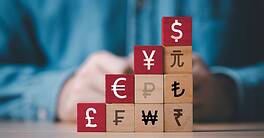The governor of the Central Bank of Kuwait speaks to Global Finance.

Global Finance: How has 2020 been for Kuwait?
Mohammad Y. Al-Hashel: Undoubtedly, this has been a tough year, not just for Kuwait but for the world at large. The Kuwaiti economy has been hit by the double whammy of a plunge in oil prices and domestic lockdowns. Shrinking global demand has kept oil prices subdued, causing noticeable deterioration in our current and fiscal accounts. And pandemic-driven social distancing measures from March to July have incapacitated the services sector, in particular.
Thankfully, there are early signs of a strong rebound, at least in domestic consumption, fueled by pent-up demand. Whether this trend is sustainable is yet to be seen, especially once the payment moratoriums expire and the impact of relief measures wanes.
GF: What was your response to Covid-19 crisis?
Al-Hashel: CBK took a range of measures to shield banks and the economy from the pandemic- triggered challenges. First, on the monetary policy front, we swiftly moved to slash our discount rate twice in March to ease the financial conditions. The policy rate was cut by a cumulative 1.25 percentage points, bringing it down to 1.5%, the lowest in decades.
Second, as the regulator of the Kuwaiti banking system, we relaxed a number of prudential limits. That included the easing of liquidity coverage and net stable funding ratios from 100% to 80%, curtailing the regulatory liquidity ratio from 18% to 15% and relaxing the maturity ladder limits.
At the same time, we enabled banks to extend more loans by increasing their maximum lending limit from 90% to 100%, releasing the capital conservation buffer, easing the loan-to-value limits for investment real estate loans in residential areas, and bringing down the credit-risk weight for SME [small and medium-size enterprise] lending from 75% to 25%. Additionally, all customers affected by Covid-19 were allowed to delay payments up to six months without any penalty, mitigating the risk of borrowers’ liquidity strains morphing into solvency problems.
Third, fees/charges on point-of-sale, ATMs and online banking transactions were waived for up to six months to promote the use of safer, digital payments instead of cash. The limit on contactless payments was also increased from 10 Kuwaiti dinars ($33) to KWD25 to reduce the need for retail cash transactions.
Moreover, fiscal authorities also introduced a range of support measures, and the banking industry voluntarily offered further support to affected customers.
GF: What are the lessons of this crisis?
Al-Hashel: Earlier, I mentioned a number of prudential limits that we relaxed in response to the Covid-19 crisis. But none of that would have been possible without accumulating sufficient buffers in the first place. That is precisely what we did during the last decade, as CBK worked closely with banks to prudently build strong buffers in somewhat benign times. As a result, our banks entered the Covid-19 crisis from a position of considerable strength, with robust capital, ample liquidity, healthy profits and abundant provisions. Our experience underscores that “the time to repair the roof is when the sun is shining,” as John F. Kennedy once said.
On a more general level, we have also learned that only close cooperation among key stakeholders can help effectively fight against a pandemic. Without the full support and commitment of health, monetary, fiscal and administrative authorities, both within and across nations, the challenge of saving lives and livelihoods could become insurmountable.
GF: Aside from Covid-19, what are the biggest challenges for the Kuwaiti economy and where do you see opportunities?
Al-Hashel: One perennial issue has been our heavy dependence on oil, which typically accounts for around 90% of government receipts. This lack of diversification makes Kuwait’s exports, public finances—and the economy in general—quite vulnerable to the swings in oil prices. While our diversification drive was already slower than desired, any such efforts have been further constrained as Covid-19 changed immediate priorities, not least by enhancing the need for government interventions in supporting economic recovery.
As our economy recovers, growing borrowing needs of firms and individuals could provide banks greater opportunities for lending. And the surge in digitization, accelerated by Covid-19, should further enable banks in offering swift, low-cost and convenient services, increasing their outreach and customer base.



